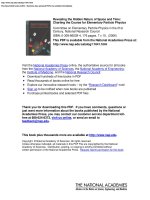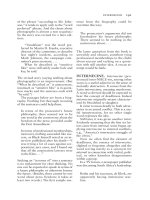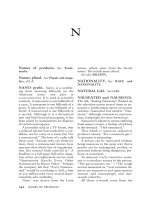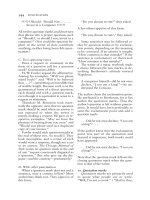The cohesive nature of international tourism, hospitality and travel businesses
Bạn đang xem bản rút gọn của tài liệu. Xem và tải ngay bản đầy đủ của tài liệu tại đây (166.55 KB, 8 trang )
Essay: You are required to prepare an essay on: The Cohesive Nature of International
Tourism, Hospitality and Travel Businesses.
Tourism is a multi-faceted phenomenon which involving with the movement and staying
when travel outside of visitors. It could be said that Tourism is a resource-oriented industry and
has a close relationship with many economic sectors including Hospitality and Travel
Businesses. This relationship will play an important role in economic development of a country.
This paper will discuss on the connection between Tourism and Hospitality as well as Tourism
with Travel Business to prove the cohesive nature of International Tourism, Hospitality and
Travel Businesses based on the reality case in Vietnam.
According to economists at the United Nations Economic and Social Council, a country
can develop Tourism steadily if it can produce wealth that could serve for this sector. Most of
economic sectors are involved in providing and promoting tourism development, so if you have
to import most equipment and goods to build facilities for tourists, then profits from tourism will
fall into the hands of foreign capitalists. Thus, developed countries which have ability to produce
international standard material will have favorable conditions to develop tourism as well as
Hospitality and Travel Business (Nguyễn Văn Đính, Trần Thị Minh Hoà, 2004).
Tourism including not just places, transport and journey, but also involving in many
entertainment venues, such as: bars and restaurants or food production, waste disposal, and the
infrastructure that supports tourism in destinations (Tapper, R., Font, X. , 2004). These services
are given by different companies, organizations and agents that constitute the tourism service
supply chain (Hu, X., Tang, Y., 2008). Bardgett (2000) explained that tourism comprises the
activities of person travelling to and staying places outside their usual environment for not more
than one consecutive year for business and other purposes. The confusion of the terminologies
between tourism, travel and hospitality could deceive researchers. Figure 1 below will describe
the relationship between the tourism, hospitality and travel industries. Services provided by the
hospitality and travel industry are apart from tourism purpose. Moreover, there are also non
tourist customers in both the hospitality industry and the travel industry. Precisely, it can be
identified the activities in the tourism industry by considering whether they serve tourist
(Piboonrungroj, P., Disney, S. M., 2009) .
Firstly, Tourism is evaluated as a cross - sectoral economy which related to many economic
sectors including transportation or travel business. When mentioning about the development of
tourism, one of the fundamental factors is transportation development. Tourism and
transportation have an intimate relationship that cannot be separated from one to another, which
is complementary to the other and vice versa. Along with the development of tourism industry,
transportation has to change in order to meet the increasing demand of people in general and of
tourists in particular. Transport sector has an enormous impact on the tourism industry. The
quality of the tourist's roads is favorable condition for the development of tourism. For good
travel destinations, it is easy for tourists to travel on the car to encourage motivation for tourism
development. For difficult roads, this will hinder tourism. To the quality of the means of
transporting tourists, when traveling, tourists tend to consume with higher quality than usual, so
they require high services to meet the demand. Today, transportation quality must be safe,
comfortable and fast. The impact of traffic could affect on the travel itineraries of tourists; it can
create good impression or bad for travel. Therefore, the travel business requires careful to study
carefully the length of the journey, the route of the trip, the chosen route to suit the quality of
roads, ensuring the safety of guests, choosing the appropriate transport service.
In Vietnam, transportation has some significant contribution to the development of tourism
which is reflected through the upgrading of the road infrastructure system, railway station, dock,
air routes, and many new markets. Network system and means of transportation by sea, river is
constantly invested to provide good travel and transportation services. From 2012, Vietnam
Prime Minister approved many strategies involving these two branches with the aim to develop
tourism. This coordination will help to improve the integration and competitiveness of
infrastructure as well as service quality. Based on that, Vietnam’s tourism will be developed in
professionalism, modern, safe, effective, ensuring the sustainable development of Vietnam
tourism brand or solving many problems affecting tourism activities. Through the cooperation
between the two sectors will promote the socialization, mobilization of investment resources and
potential strength of the country. According to the content of those strategies, the Ministry of
Culture, Sports and Tourism shall have responsibility to provide and exchange the information
on the deployment of tourist events in current or future so that the Ministry of Communications
and Transport can prepare plans that are synchronous and unified. Tourism and functional units
of the culture, sports and tourism sector will promote the propaganda, dissemination, guidance
and education of traffic safety and many important laws for tourists when visiting Vietnam,
directing tourist enterprises to observe traffic and transport law as well as encouraging tourist
enterprises to invest in modern works and means of transport for specialized transportation and
accommodation. Those two sectors will cooperate in training and fostering legal knowledge on
traffic for tour guides team and service providers, improving reception knowledge for officials
and employees in the travel industry and ensuring courteous behaviors for tourists. The Ministry
of Transport will actively provide the tourism industry information which related to development
of infrastructure and transportation services in order to create favorable conditions for partner to
develop sustainable tourism, ensuring safety for visitors. In the road sector, the sector will focus
on investment in transport infrastructure linking with national highways to national parks and
resorts; promoting the development of stopovers on national highways, meeting the needs of
tourists, introducing local products and souvenirs to tourists. Those two sectors will implement
road transport agreements; bring out many policies to create favorable conditions for visitors to
bring road transport vehicles into Vietnam for tourism purposes. By air, the transport sector will
strengthen the link between key domestic tourist and international destination and increase the
frequency of airport operations during peak periods of travel; expansion and modernization of
airport facilities, terminals and ground service and air transport services. The cooperation
between the two sectors also focuses on upgrading the operation of rail and sea services to bring
best services for visitors when coming to Vietnam. Particularly, it promotes the development of
the seaport service in receiving international tourist ships etc. (Nhandan, 2012 )
The hospitality is relatively dependent on tourism resources. Wherever there are a lot of
tourism resources, tourism attractiveness and high tourism receipt, it will decide on the scale and
type of business of the hotel. Thereby, it also determines the business efficiency of the hotel. This
is a very distinct feature for other types of services, because other services, they do not need to
pay much attention to tourism resources. It is known that tourism resources are a precondition for
people to travel. First a hotel that wants to attract visitors, it must be located at a tourist
destination, there may be a lot of hotels to be built, a hotel that attracts visitors must unique,
harmonious with the surrounding landscape, if the ancient features, the interior must also be full
of modern facilities to meet the high requirements of tourists. According to the newest
information provided at the "Conference on Investment and Hotel Business in Vietnam 2017" by
Vietnam Tourism Association, Vietnam Hotel Association, Hospitality occupies 70% of tourism
revenue. At present, the total number of tourism accommodation facilities rooms increased from
69 thousand rooms in 2001 to 420 thousand rooms in 2016. And so far there are more than 21
thousand tourism accommodations facilities have appeared which are more diverse, apart from
hotels, motels, such as resort hotels, tourist apartments, tourist villas, etc. Those have contributed
to bring Vietnam's hotel system on a par with other developed countries in the region. Especially
large scale of tourism accommodations facilities are invested in tourism centers and coastal areas
in Nha Trang, Mui Ne (Phan Thiet - Binh Thuan), Phu Quoc, Ha Noi, Ha Long, Hue, Da Nang
City, Hoi An, HCM city etc. And business efficiency of tourism accommodations facilities
system is accounted for about 70% turnover of the tourism industry in Vietnam.
In conclusion, the tourism industry is a spearhead economic sector which brings many
benefits to a country, such as: big source of foreign exchange, bringing the country’s culture to
the world and receives the cultural values through the foreign tourists. Parallel to the
development of tourism is the development of infrastructure, especially traffic. Only when traffic
is of high quality to ensure safety and security will attract domestic and foreign tourists.
Upgrading traffic infrastructure, reducing traffic jams, developing and expanding airports,
opening new routes not only meaningful for the development of tourism but also worthy of the
face of a country. In contrast, in order to attract tourists to visit, the transportation industry have
to improve to meet the needs of tourists. In addition, it is necessary to complete institutional
policies on investment, create incentive mechanisms and conditions to attract investors; To
reserve the land fund for the construction of tourism accommodations facilities according to the
planning, publicize the planning on tourism accommodations facilities development in the
locality in each period so as to contribute to the system of hotels on a par with other developed
countries in the region. So the relationship among transport, tourism and hospitality is a close
relationship, interacting with one another to help one another develop together.
REFERENCES
Hu, X., Tang, Y. (2008). Integrated tourism service supply chain management: concept and
operation process.
Kinh doanh khách sạn là gì? (2017, January 17). Retrieved October 7, 2017, from Hotel:
/>Loi, T. (2017, April 27). Ngành khách sạn, lưu trú chiếm 70% doanh thu du lịch. Retrieved
October 7, 2017, from Du lich Viet Nam: />
Nguyễn Văn Đính, Trần Thị Minh Hoà. (2004). Giáo trình Kinh tế Du lịch. Hà Nội : Lao đông –
Xã hội Publisher.
Nhandan. (2012 , 11 26). Van hoa. Retrieved October 7, 2017, from Baomoi.com:
/>Piboonrungroj, P., Disney, S. M. (2009). Tourism supply chains: a conceptual framework.
Pizam, A. (2009). Editorial : Green hotels: A fad, ploy or fact of life? International Journal of
Hospitality Management .
Tapper, R., Font, X. . (2004). Tourism supply chain: Report of a desk research project for the
travel foundation.









